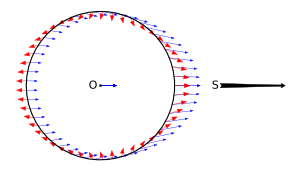

In astrophysics, spaghettification (sometimes referred to as the noodle effect)[1] is the vertical stretching and horizontal compression of objects into long thin shapes (rather like spaghetti) in a very strong, non-homogeneous gravitational field. It is caused by extreme tidal forces. In the most extreme cases, near a black hole, the stretching and compression are so powerful that no object can resist it. Within a small region, the horizontal compression balances the vertical stretching so that a small object being spaghettified experiences no net change in volume.
Stephen Hawking described the flight of a fictional astronaut who, passing within a black hole's event horizon, is "stretched like spaghetti" by the gravitational gradient (difference in gravitational force) from head to toe.[2] The reason this happens would be that the gravitational force exerted by the singularity would be much stronger at one end of the body than the other. If one were to fall into a black hole feet first, the gravity at their feet would be much stronger than at their head, causing the person to be vertically stretched. Along with that, the right side of the body will be pulled to the left, and the left side of the body will be pulled to the right, horizontally compressing the person.[3] However, the term spaghettification was established well before this.[4] Spaghettification of a star was imaged for the first time in 2018 by researchers observing a pair of colliding galaxies approximately 150 million light-years from Earth.[5]
- ^ Wheeler, J. Craig (2007), Cosmic catastrophes: exploding stars, black holes, and mapping the universe (2nd ed.), Cambridge University Press, p. 182, ISBN 978-0-521-85714-7
- ^ Hawking, Stephen (1988). A Brief History of Time. Bantam Dell Publishing Group. p. 256. ISBN 978-0-553-10953-5.
- ^ Astronomy. OpenStax. 2016. p. 862. ISBN 978-1938168284.
- ^ Calder, Nigel (1977). The Key to the Universe: A Report on the New Physics. Viking Press. p. 143. ISBN 978-0-67041270-9. Retrieved July 10, 2022. Published as a companion to the BBC TV documentary The Key to the Universe.
- ^ "Astronomers See Distant Eruption as Black Hole Destroys Star" (Press release). National Radio Astronomy Observatory. Phys.org. June 14, 2018. Retrieved June 15, 2018.